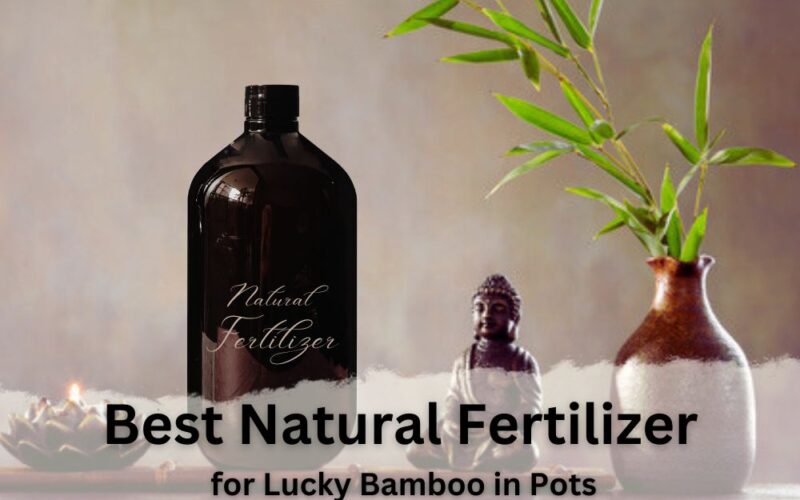Here you will learn about the best natural fertilizer for lucky bamboo along with pro tips for using it in soil and water-based environments.
Do you know what is a natural fertilizer? When we add organic materials to soil or water to provide essential nutrients for plants, we use a natural fertilizer. Most of the natural fertilizers come from animal waste, plant matter, and minerals. For example, Fish emulsion fertilizer that is made from fish waste.
In this article, you will find 4 of the best natural fertilizers for lucky bamboo. If you have lucky bamboo in your houseplant collection (or going to add it) and are searching to find a natural fertilizer, keep reading.
As I told you in my previous article about houseplant bamboo care, lucky bamboo doesn’t need a lot of fertilization. However, you must add proper fertilizer to improve its growth. Using synthetic fertilizers for a long time may cause problems for your plant, hence most gardeners prefer to use a natural fertilizer for lucky bamboo to promote plant growth.
In the following, you will find a list of the best Natural fertilizers for lucky bamboo. Before it, read about the general tips that you must consider about a natural fertilizer.
➡ You can hear the audio version of this article too.
General Tips for Using a Natural Fertilizer

- Always follow the recommended dosage and instructions provided on the packaging.
- Water your lucky bamboo thoroughly before applying any fertilizer to prevent root burn.
- Monitor your plant’s response to fertilizers. If you notice any signs of fertilizer burn (leaf discolouration, wilting, or stunted growth), reduce the frequency or concentration of fertilizers.
- Regularly flush the soil with plain water to prevent salt buildup from fertilizers.
- Observe your lucky bamboo for signs of nutrient deficiencies or excesses, and adjust your fertilization routine accordingly.
- Each plant may have specific needs, so it’s essential to monitor your lucky bamboo’s health and adjust your fertilization practices accordingly.
Now, common to find the best natural fertilizer for lucky bamboo in pots.
Liquid Seaweed Fertilizer: A Comprehensive Natural Fertilizer for Lucky Bamboo

Seaweed-based fertilizers provide essential nutrients and trace elements that promote healthy growth. This natural fertilizer for lucky bamboo contains macronutrients like nitrogen, phosphorus, and potassium and micronutrients such as iron, manganese, zinc, copper, and boron.
You can purchase liquid seaweed fertilizer from a garden supply store or online.
- Follow the instructions on the packaging for dilution ratios.
- Typically, you’ll need to dilute the liquid seaweed fertilizer with water in a watering can or spray bottle.
- Once diluted, use the mixture to water your lucky bamboo according to its watering needs. You can read my previous article about the best ways to water lucky bamboo to find out more tips on this issue.
Some Pro Tips for Using Liquid Seaweed Fertilizer for Your Lucky Bamboo
- Use liquid seaweed fertilizer as a foliar spray in addition to watering the roots. This natural fertilizer for lucky bamboo allows the plant to absorb nutrients through its leaves.
- As I told you in my previous article about how to fertilize lucky bamboo, you have to, you must apply liquid seaweed fertilizer during the plant’s active growth phase, typically in spring and summer.
- Avoid using liquid seaweed fertilizer during the plant’s dormant period in winter.
Notes for Using Liquid Seaweed Fertilizer in Water-Based Environments
- Dilute liquid seaweed fertilizer according to the recommended dosage provided on the packaging.
- Add the diluted liquid seaweed fertilizer directly to the water in your lucky bamboo container.
- Apply the fertilizer every 4-6 weeks during the active growing season.
Fish Emulsion: Best Natural Fertilizer for Lucky Bamboo

Fish emulsion is a natural fertilizer made from fish waste. It is rich in nitrogen, which promotes green foliage growth. In addition to Nitrogen, this natural fertilizer for lucky bamboo is a good source of phosphorus, potassium and several trace elements including calcium, magnesium, sulfur, and iron.
As I told you before (best fertilizer for lucky bamboo) this indoor plant needs a balanced fertilizer but the N-P-K ratio of Fish emulsion varies depending on the product.
You must buy fish emulsion fertilizer from a garden supply store or online. After that. You must:
- Read the instructions on the packaging for dilution ratios.
- Generally, you’ll need to dilute the fish emulsion with water in a watering can or spray bottle.
- Dilute this natural fertilizer for lucky bamboo according to the recommended ratio.
- Use the diluted fish emulsion to water your lucky bamboo, ensuring you cover the roots and soil thoroughly.
Some Pro Tips for Using Fish Emulsion Fertilizer for Your Lucky Bamboo
- Dilute fish emulsion with water according to the recommended ratio to prevent over-fertilization and potential damage to the plant.
- Apply fish emulsion every 4-6 weeks during the growing season.
- Water your lucky bamboo with plain water before and after applying fish emulsion to avoid any potential odour.
Notes for Using Fish Emulsion in Water-Based Environments
- As I told above, Dilute fish emulsion with water according to the recommended ratio on the product label.
- Add the diluted fish emulsion to the water in your lucky bamboo container.
- Apply the fertilizer every 4-6 weeks during the active growing season.
Compost Tea: A Nutrient-Rich Natural Fertilizer for Lucky Bamboo

Compost tea is a nutrient-rich liquid fertilizer made from steeping compost in water. This natural fertilizer for lucky bamboo provides a balanced mix of nutrients and beneficial microorganisms. Let me show you how to make your homemade natural fertilizer for lucky bamboo by Compost tea:
- Fill a cloth or mesh bag with compost or vermicompost (worm castings).
- Place the bag in a large container, such as a bucket or barrel.
- Fill the container with water, allowing the compost to steep.
- Let the compost steep in water for about 24 to 48 hours, occasionally stirring the mixture.
- After steeping, remove the bag of compost.
- Dilute the compost tea by mixing it with clean water in a watering can.
- Use the diluted compost tea to water your lucky bamboo, ensuring the roots and soil are thoroughly moistened.
Some Pro Tips for Using Compost Tea Fertilizer for Your Lucky Bamboo
In my previous article, I showed you the best fertilizers for lucky bamboo in water. Here, you can find tips that let you use compost tea in water-based environments too.
- Use well-aged compost or vermicompost to make compost tea for optimal nutrient content.
- Aerate the compost tea mixture occasionally by stirring it gently to promote the growth of beneficial microorganisms.
- Apply compost tea every 2-4 weeks during the growing season, reducing the frequency during the dormant period.
Notes for Using Compost Tea in Water-Based Environments
- Instead of directly adding compost tea to the water, you can use it to water the roots of your lucky bamboo.
- Prepare compost tea by steeping compost or vermicompost in water for a certain period (usually 24-48 hours).
- After steeping, use the compost tea to water the roots of your lucky bamboo, ensuring the water level in the container remains appropriate for the plant.
Epsom Salt: A Magnesium-Rich Natural Fertilizer for Lucky Bamboo

Epsom salt is not a traditional fertilizer but can be used occasionally as a natural fertilizer for lucky bamboo to provide magnesium, which is beneficial for plants’ overall health.
- Dissolve a small amount of Epsom salt in water.
- The general recommendation is to use about 1 tablespoon of Epsom salt per gallon of water.
- Stir the mixture until the Epsom salt is completely dissolved.
- Use the diluted Epsom salt solution sparingly to water your lucky bamboo.
Some Pro Tips for Using Epsom Salt Fertilizer for Your Lucky Bamboo
- Use Epsom salt as an occasional supplement rather than a regular fertilizer. Overuse can lead to magnesium buildup in the soil.
- Apply the diluted Epsom salt solution directly to the soil, avoiding foliage contact.
- Use this natural fertilizer for lucky bamboo sparingly, about once every 2-3 months or as needed if you notice signs of magnesium deficiency, such as yellowing leaves.
Notes for Using Epsom Salt in Water-Based Environments
- Epsom salt is not typically used in water-based environments for lucky bamboo since it is primarily applied to the soil or growing medium.
- If you wish to provide magnesium to your lucky bamboo in water, you can consider using magnesium sulfate supplements specifically formulated for hydroponic systems. Follow the instructions provided on the product packaging for proper usage.
Conclusion
Lucky bamboo is one of the most popular types of indoor bamboo plants. Here, I tried to provide you with a list of the best natural fertilizers for lucky bamboo along with how to provide them. I also told you pro tips for using them in soil and water.
Have you ever used the natural fertilizers for plants? why do you prefer them to synthetic fertilizers? Please share your ideas and experiences below this page.

Elahe Rabiei
Hi, I’m Elaheh. My Academic major is plant protection, and houseplants are my expertise. As a houseplant lover, my house is full of indoor plants and it is my passion to take care of them. Hence, I’m here to share my knowledge and experience about growing healthy houseplants. I am also a plant protection advisor, so feel free to ask me any questions you may have.

